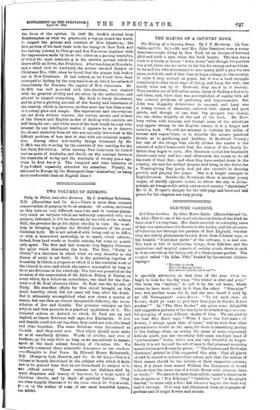OLD-TIME GARDENS.
Old-Time Gardens. By Alice Morse Earle. (Macmillan and Co. 8s. 6d.)—This is one of the most satisfactory books of the kind we have seen f r a long time. Mrs. Earle succeeds in conveying some of her own enthusiasm for flowers to the reader, and the pleasure of following her through the gardens of New England, whether they are stately pleasaunces handed down from Colonial days, or the humble "front-door yards" of the cottages, is a real one. The book is full of interesting things, from folk-lore and the mysterious and magical aspects of certain plants down to such m siern conceits as the laying out of a Shakespeare garden. The chapter called "In Lilac Tide," headed by the ancient Chinese saying—
"Em man is aware That the Spring is here
The Bowers have found it out"—
is specially attractive at that time of the year when we begin to look for the day when "the winter is over and gone." She loves the " laylock," to call it by the old name, which seems to have more scent in it than the other. " Blue.pipe " tree was another name for it, and she once heard it used by an old Narragansett coach-driver: "Ye set such store on flowers, don't ye want to pick that blue-pipe in Pender Zuke's garden ?" In "The Blue Border" she gives some delightful and suggestive pictures of the beauty to be attained by a success- ful grouping of many different shades of blue. We are glad to see that Mrs. Earle says, "When I know the folk-names of flowers, I always speak thus of them," and we wish that other garden-lovers would do the same, for there is something jarring to the feelings when, on asking the name of some exquisitely delicsto plant, you are cheerfully told some crackjaw word of
portmanteau" Latin, which you are only thankful to forget. Surely it is not beyond the wit of man to find pleasant.sounding names for the new flowers he grows. " ' The Curious and Profitable Gardener,' printed in 1730, suggested this plan : That all plants should be named to indicate their colour, and that the initials of their names should be the initials of their respective colours ; thus, if a plant were named William the Conqueror it would indicate that the name was of a white flower with crimson lines or shades," We cannot do more than call the reader's attention to the chapters on "Box Edgings," "Sundials," and "A Moonlight Garden," to name only a few; but whoever begins the b4ok will read it through. It is very well illustrated from photographs of gardens and of single flowers and shrubs.


























































 Previous page
Previous page